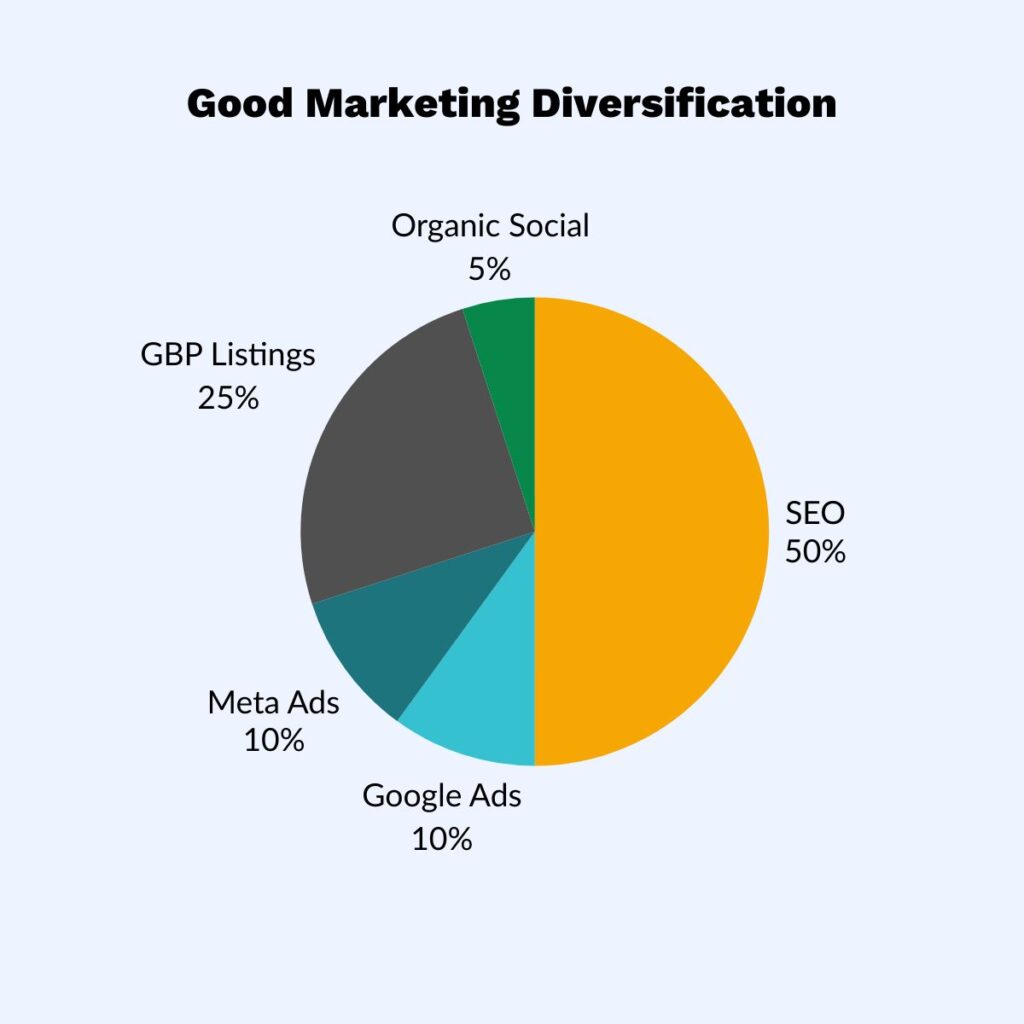
Attracting and retaining patients is a challenge for any medical practice. With increasing competition and evolving patient expectations, practices need a strong marketing strategy to grow and thrive. Yet many practices fall into the trap of relying on just one marketing channel, usually referrals. Depending too much on a single channel is risky—just like putting all your money into a single stock.
In the investment world, portfolio diversification is the key to long-term financial growth. By spreading investments across different assets, investors minimize risk and create a more stable, predictable path to success.
The same principle applies to marketing. A well-balanced, diversified marketing strategy allows medical practices to reduce reliance on any single channel, and is more effective at growing overall patient gains.
Why Relying on A Single Marketing Channel is Risky
1. Unpredictability: Platforms Change
Marketing platforms, like investments, are subject to external forces that can change overnight. Google frequently updates its search algorithms, which can significantly impact a practice’s organic traffic. Social media platforms, such as Facebook and Instagram, continually tweak their algorithms, often reducing the reach of unpaid content. These changes can make it harder for practices to maintain consistent patient growth.
2. Vulnerability: Practice Competition
A medical practice that depends exclusively on one marketing channel is vulnerable to competitive forces. Competitors can outbid or outspend you on Google Ads, or outrank you in SEO. By using multiple marketing channels, practices can mitigate these risks.
3. Missed Opportunities: Patients Prefer Different Channels
Lastly, not all patients find a physician in the same way. Some prefer searching Google for top-rated doctors, while others trust social media recommendations or online reviews. A single-channel approach means missing out on entire segments of potential patients who engage with different platforms.
Building a Diversified Medical Marketing Strategy
In investing, portfolio diversification means spreading assets across various investment types to minimize risk and maximize returns over time. Instead of putting all their money into one stock, a smart investor will allocate funds across stocks, bonds, real estate, and other assets to create a balanced portfolio.
The goal of diversification is stability, resilience, and consistent growth. A diverse portfolio helps investors withstand market fluctuations and economic downturns while ensuring steady financial progress.

We think this same principle can be applied to medical practice marketing. Here’s how to think about the different “asset classes” in a diversified medical marketing strategy.
1. Local SEO – The Reliable Bond Investment
Just as bonds provide steady, low-risk returns, local SEO serves as the foundation of a medical practice’s marketing strategy. It compounds over the long term while consistently generating patient leads.
- Your practice and physician Google Business Profile listings should be your bread and butter for patient growth. They are the best channel at driving local patients, and make up your largest segment of “organic” SEO leads.
- But it takes time to build credibility and accumulate positive patient reviews.
2. Paid Advertising – The High-Yield Investment
Paid advertising is like investing in high-growth stocks—it can generate quick returns but must be managed and optimized frequently.
- Google Ads allow you to rank at the top of search results immediately.
- These ads are also the only ad types that target patients with the highest intent – when they’re actively searching for a physician or researching conditions and treatments.
- Paid ads provide fast results, making them the best way to see immediate results in generating new patient leads and office visits.
3. Website SEO – The Long-Term Investment
Website SEO (like publishing blogs or optimizing your website for SEO traffic) is a long-term strategy, with traffic growing slowly over time. Like an index fund, you’re investing over time and weathering the ups and downs of the market.
- A well-optimized website with strong on-page SEO, high-quality content, and technical SEO best practices can consistently attract organic traffic.
- Like an index fund, SEO performance is subject to Google’s algorithm changes.
Understanding Your Practice’s Risk Tolerance & Growth Goals
In investing, some people prefer high-risk, high-reward strategies, while others prioritize stability and steady growth. The same concept applies to marketing for medical practices.
- High-growth strategies (such as PPC advertising and paid social ads) require a larger budget but deliver faster patient acquisition.
- Low-risk strategies (such as local SEO) take time to build but provide long-term sustainability.
Adjusting the Portfolio: Measuring & Optimizing Performance
Just as investors routinely assess their portfolios and make adjustments, medical practices must track, analyze, and optimize their marketing strategies to make sure all channels are working together as a system to address both short and long-term goals.
A medical practice that diversifies its marketing approach—just like a well-balanced investment portfolio—is more resilient and more likely to see sustained growth in new patients. Relying on a single channel can be risky, but leveraging both organic and paid marketing strategies can minimize risk and attract a broader audience.
If your practice is ready to build a strategic, diversified marketing plan that attracts more patients, request a no-obligation consultation and speak with one of our RUNNER medical marketing experts.




